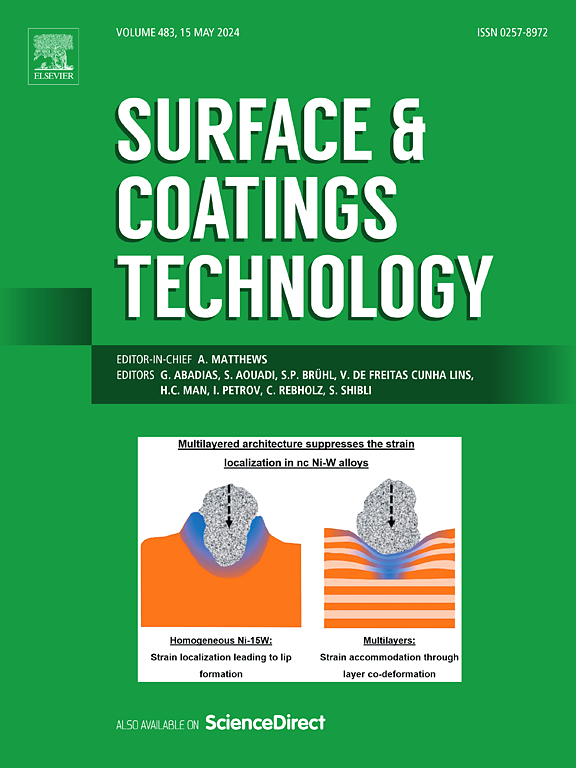Unveiling the synergy of MXene supported ZIF-8 hybrid catalyst for enhanced oxygen evolution reaction
IF 5.3
2区 材料科学
Q1 MATERIALS SCIENCE, COATINGS & FILMS
引用次数: 0
Abstract
The oxygen evolution reaction (OER) is a critical process in sustainable energy technologies, but its sluggish kinetics necessitate efficient, non-precious metal catalysts. ZIF-8 has recently gained attention as a model electrocatalyst due to its porous structure, functional channels, and high Brunauer-Emett-Teller (BET) surface area. However, its poor conductivity and aggregation hinder its OER performance. MXene, a family of multifunctional 2D material with rich surface chemistry, shows great promise as a catalyst support material. This study presents the synthesis of ZIF-8 and MXene composites (MXene@ZIF-8) with varying ZIF-8 concentrations while maintaining a constant MXene mass to evaluate the supportive function of MXene in improving the OER performance of the composite. The optimized MXene@ZIF-8 (1:5) catalyst achieved superior performance, with a reduced overpotential (330 mV) and Tafel slope (149.79 mV/dec) compared to ZIF-8 (579 mV, 351.38 mV/dec) and MXene (613 mV, 400.02 mV/dec). It also exhibited exceptional durability, maintaining stability at 10 mA/cm2 for 50 h in alkaline condition. The enhanced performance stems from its increased BET and electrochemically active surface areas. The incorporation of MXene introduces mesopores, increases pore volume, enhances hydrophilicity, and reduces charge transfer resistance, collectively facilitating efficient electrolyte diffusion and reactant accessibility. This study underscores MXene's potential as an efficient and cost-effective support material for advancing OER catalysts, facilitating the development of advanced sustainable energy solutions.
揭示MXene负载的ZIF-8杂化催化剂在增强析氧反应中的协同作用
析氧反应(OER)是可持续能源技术中的一个关键过程,但其缓慢的动力学需要高效的非贵金属催化剂。ZIF-8由于其多孔结构、功能通道和高的BET比表面积,近年来作为一种典型的电催化剂而受到关注。但其导电性差、聚集性差,影响了其OER性能。MXene是一类具有丰富表面化学性质的多功能二维材料,是一种很有前景的催化剂载体材料。本研究在保持MXene质量不变的情况下,合成了不同ZIF-8浓度的ZIF-8和MXene复合材料(MXene@ZIF-8),以评估MXene对提高复合材料OER性能的支持作用。与ZIF-8 (579 mV, 351.38 mV/dec)和MXene (613 mV, 400.02 mV/dec)相比,优化后的MXene@ZIF-8(1:5)催化剂的过电位(330 mV)和Tafel斜率(149.79 mV/dec)均有所降低。它还表现出优异的耐久性,在碱性条件下保持稳定在10 mA/cm2 50小时。增强的性能源于其增加的BET和电化学活性表面积。MXene的加入引入了介孔,增加了孔体积,增强了亲水性,降低了电荷转移阻力,共同促进了有效的电解质扩散和反应物的可及性。这项研究强调了MXene作为一种高效且具有成本效益的支撑材料的潜力,可以促进OER催化剂的发展,促进先进可持续能源解决方案的发展。
本文章由计算机程序翻译,如有差异,请以英文原文为准。
求助全文
约1分钟内获得全文
求助全文
来源期刊

Surface & Coatings Technology
工程技术-材料科学:膜
CiteScore
10.00
自引率
11.10%
发文量
921
审稿时长
19 days
期刊介绍:
Surface and Coatings Technology is an international archival journal publishing scientific papers on significant developments in surface and interface engineering to modify and improve the surface properties of materials for protection in demanding contact conditions or aggressive environments, or for enhanced functional performance. Contributions range from original scientific articles concerned with fundamental and applied aspects of research or direct applications of metallic, inorganic, organic and composite coatings, to invited reviews of current technology in specific areas. Papers submitted to this journal are expected to be in line with the following aspects in processes, and properties/performance:
A. Processes: Physical and chemical vapour deposition techniques, thermal and plasma spraying, surface modification by directed energy techniques such as ion, electron and laser beams, thermo-chemical treatment, wet chemical and electrochemical processes such as plating, sol-gel coating, anodization, plasma electrolytic oxidation, etc., but excluding painting.
B. Properties/performance: friction performance, wear resistance (e.g., abrasion, erosion, fretting, etc), corrosion and oxidation resistance, thermal protection, diffusion resistance, hydrophilicity/hydrophobicity, and properties relevant to smart materials behaviour and enhanced multifunctional performance for environmental, energy and medical applications, but excluding device aspects.
 求助内容:
求助内容: 应助结果提醒方式:
应助结果提醒方式:


